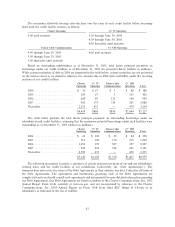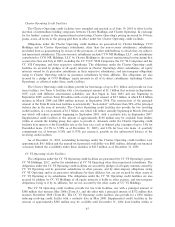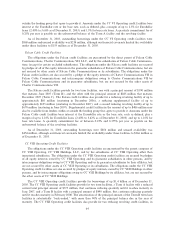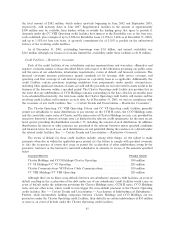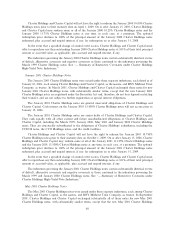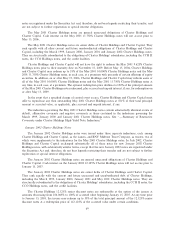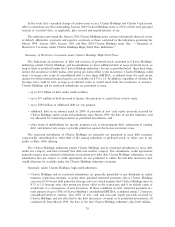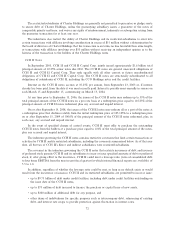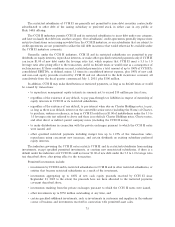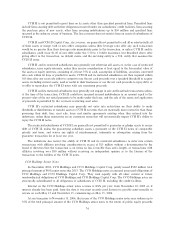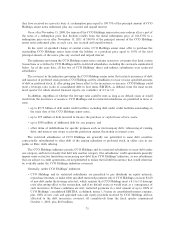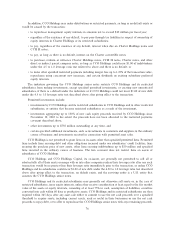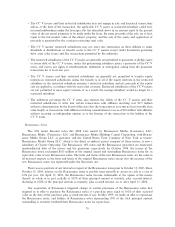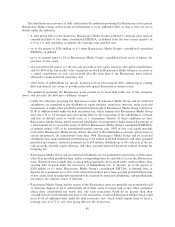Charter 2003 Annual Report Download - page 72
Download and view the complete annual report
Please find page 72 of the 2003 Charter annual report below. You can navigate through the pages in the report by either clicking on the pages listed below, or by using the keyword search tool below to find specific information within the annual report.In the event that a speciÑed change of control event occurs, Charter Holdings and Charter Capital must
oÅer to repurchase any then outstanding January 2002 Charter Holdings notes at 101% of their total principal
amount or accreted value, as applicable, plus accrued and unpaid interest, if any.
The indentures governing the January 2002 Charter Holdings notes contain substantially identical events
of default, aÇrmative covenants and negative covenants as those contained in the indentures governing the
March 1999, January 2000, January 2001 and May 2001 Charter Holdings notes. See ""Ì Summary of
Restrictive Covenants under Charter Holdings High-Yield Note Indentures.''
Summary of Restrictive Covenants under Charter Holdings High-Yield Notes.
The limitations on incurrence of debt and issuance of preferred stock contained in Charter Holdings'
indentures permit Charter Holdings and its subsidiaries to incur additional debt or issue preferred stock, so
long as there is no default under the Charter Holdings indentures. Except as provided below, these limitations
restrict the incurrence of debt unless, after giving pro forma eÅect to the incurrence, Charter Holdings could
meet a leverage ratio (ratio of consolidated debt to four times EBITDA, as deÑned, from the most recent
quarter for which internal Ñnancial reports are available) of 8.75 to 1.0. In addition, regardless of whether the
leverage ratio could be met, so long as no default exists or would result from the incurrence or issuance,
Charter Holdings and its restricted subsidiaries are permitted to issue:
‚ up to $3.5 billion of debt under credit facilities,
‚ up to $75 million of debt incurred to Ñnance the purchase or capital lease of new assets,
‚ up to $300 million of additional debt for any purpose,
‚ additional debt in an amount equal to 200% of proceeds of new cash equity proceeds received by
Charter Holdings and its restricted subsidiaries since March 1999, the date of our Ñrst indenture, and
not allocated for restricted payments or permitted investments, and
‚ other items of indebtedness for speciÑc purposes such as intercompany debt, reÑnancing of existing
debt, and interest rate swaps to provide protection against Öuctuation in interest rates.
The restricted subsidiaries of Charter Holdings are generally not permitted to issue debt securities
contractually subordinated to other debt of the issuing subsidiary or preferred stock, in either case in any
public or Rule 144A oÅering.
The Charter Holdings indentures permit Charter Holdings and its restricted subsidiaries to incur debt
under one category, and later reclassify that debt into another category. Our subsidiaries' credit agreements
generally impose more restrictive limitations on incurring new debt than Charter Holdings' indentures, so our
subsidiaries that are subject to credit agreements are not permitted to utilize the full debt incurrence that
would otherwise be available under the Charter Holdings indenture covenants.
Generally, under Charter Holdings' high-yield indentures:
‚ Charter Holdings and its restricted subsidiaries are generally permitted to pay dividends on equity
interests, repurchase interests, or make other speciÑed restricted payments only if Charter Holdings
can incur $1.00 of new debt under the leverage ratio test, which requires that Charter Holdings meet an
8.75 to 1.0 leverage ratio after giving pro forma eÅect to the transaction and if no default exists or
would exist as a consequence of such incurrence. If those conditions are met, restricted payments in a
total amount of up to 100% of Charter Holding's consolidated EBITDA, as deÑned, minus 1.2 times its
consolidated interest expense, plus 100% of new cash and non-cash equity proceeds received by
Charter Holdings and not allocated to the debt incurrence covenant or to permitted investments, all
cumulatively from March 1999, the date of the Ñrst Charter Holdings indenture, plus $100 million.
70




